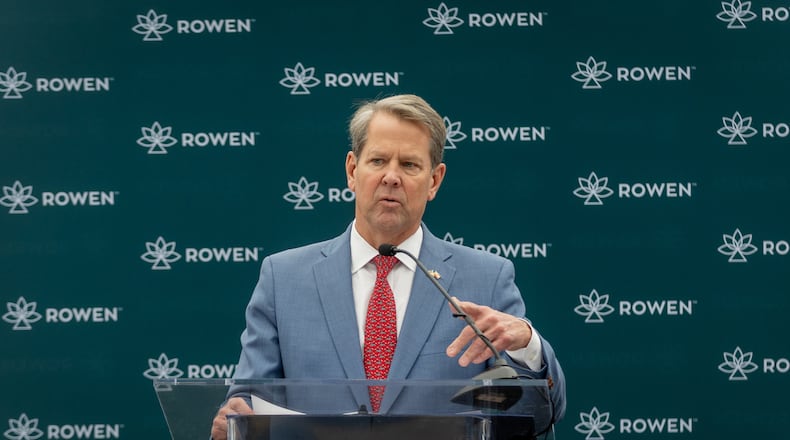Gov. Brian Kemp, U.S. Rep. Carolyn Bourdeaux, Gwinnett County Chairwoman Nicole Love Hendrickson and dozens of local dignitaries broke ground Friday on the immense Rowen development east of Dacula, kicking off construction of the planned hub for research in agriculture, medicine and environmental science.
Instead of turning over earth to lay concrete, the officials gathered around a newly-planted beech tree despite afternoon rain showers. The tree was chosen because beeches dominate the mostly forested 2,000 acres where Rowen will be built, and they live hundreds of years.
“We’re not just breaking ground,” said Mason Ailstock, president of the Rowen Foundation, a nonprofit managing the development. “We’re cultivating the future.”
Often compared to Research Triangle Park in North Carolina, where Ailstock was chief operating officer, officials expect Rowen to become a global destination for life science research jobs and innovation. They said its location, equidistant from Atlanta, Gainesville and the University of Georgia campus in Athens, will attract local and international talent.
In a speech, Kemp referred to his hometown of Athens and commended Gwinnett leaders, especially former county Chairman Charlotte Nash, for financing and supporting the project.
“I know that we’ll be meeting again here soon to be cutting ribbons and doing more groundbreakings,” Kemp said, adding, “We’re finally making University Parkway worthy of its name.”
Several local mayors and state legislators joined the crowd of about 150 in a tent to mark the occasion.
Bourdeaux said Congress is increasing funding for research and technology through this year’s inflation reduction and infrastructure laws.
“By having a place like this, we’re better positioned to take advantage of that,” she said.
Credit: Hand out
Credit: Hand out
The Rowen Foundation predicts the development will create about 90,000 jobs this century and contribute about $9 billion a year to Georgia’s economy.
The foundation is working on recruiting the first company or companies who would set up as the development’s founding partners. Rowen Foundation President Mason Ailstock said he hopes within 15 months to announce an agreement.
Kemp declined to say anything about the prospects except that the Georgia Department of Economic Development would partner with the Gwinnett County commission and local development agencies to negotiate with them.
Reeves Young, based in Sugar Hill, will kick off construction by building a two-mile stretch of pedestrian- and cyclist-friendly “complete street” leading from Route 316 into the development site. The county is spending $15.5 million on the street and loaned the Rowen Foundation the remainder of the $16.5 million cost for infrastructure, including telecommunications, gas and water lines.
Rowen is pursuing a platinum certification from the U.S. Green Building Council for its streets, which will include environmentally-conscious features such as a storm water system that directs all runoff back into the earth on site, landscaping with diverse native plants and limited use of concrete.
Gwinnett County bought the land for Rowen two years ago and has invested almost $100 million in the project so far, mostly in loans that will be repaid with 2% interest as parcels are sold to companies.
The plans include more than 22 million square feet of lab, office and public spaces. The first road will eventually lead to a mixed-use village with multi-family homes, cafes, startup hubs, parks and public trails. Larger companies would build facilities in areas of the development zoned for low or medium density.
Full buildout is expected to take 60 years.
Most of the tract now is pine forest. The foundation also plans to install markers and other features honoring the land’s history as a place where Native Americans — and later, white settlers — farmed and practiced medicine.
About the Author
Keep Reading
The Latest
Featured




